LG calls effective for steps to wipe out terrorism from Jammu
Lt. Governor Manoj Sinha, on Thursday, stressed strengthening border security against asymmetric threats due to the porous border with riverine and difficult mountain ranges.
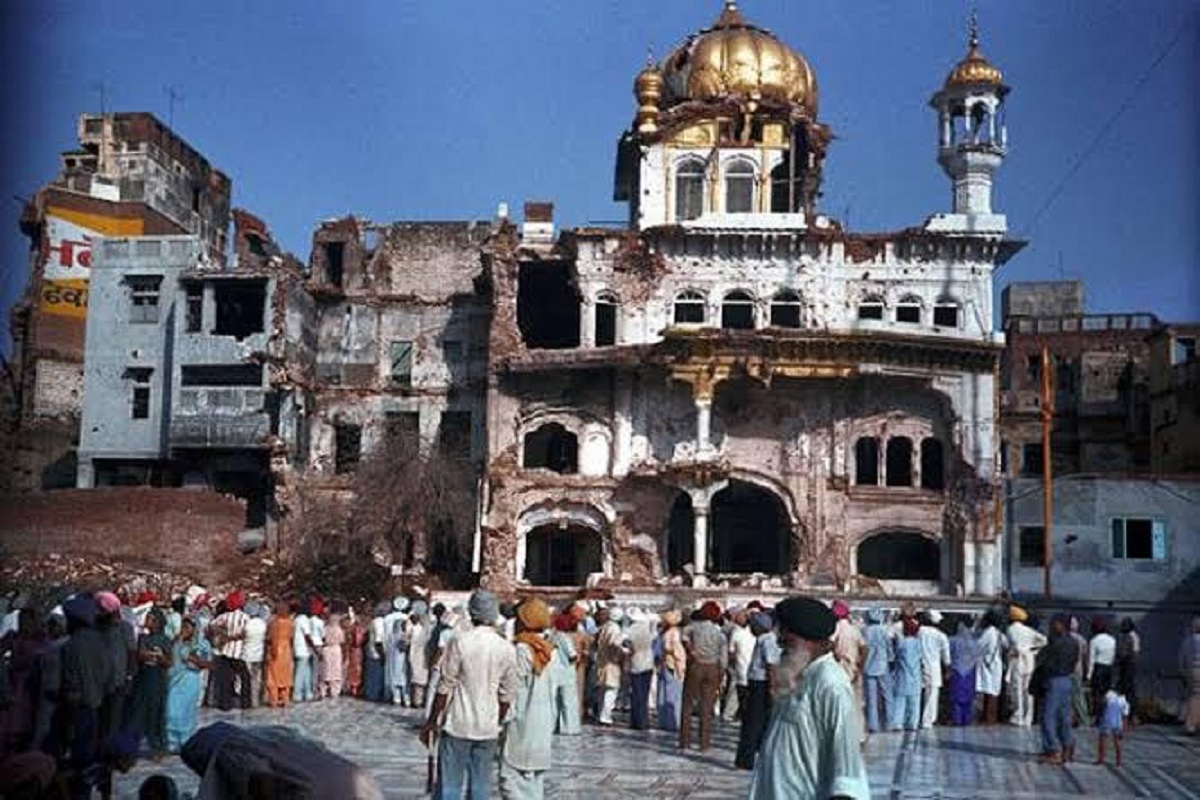
Photo: File photo
In the first week of June 1984, Punjab was simmering in the days leading up to the Operation Bluestar. One could smell fear in the air as tangibly as any odour.
“When we smelt rotten mangoes from a truck mangled into another vehicle as we drove past it, it had an eeriness to it, when we passed by a halwai (sweat shop) the odour of jalebis had an accompanying smell of fear,” Shammi Sarin, a former Amritsar-based journalist says.
Advertisement
As one travelled from Chandigarh into deeper Punjab one felt uncertain. Amritsar locally called Umbarsar was the epicenter of that fear. And those who lived around it just had prayers on their lips. Garlands of fresh marigold meant to be placed at the sanctum sanctorum were strewed all over. And scorching heat perished them faster.
Advertisement
In Delhi, there was two hotlines – one between Indira Gandhi and the Indian Army generals about to order troops to enter the Golden Temple, and another between Indira Gandhi and the world leaders interested in the goings on in Punjab. From Margaret Thatcher to Ronald Reagan to Mikhail Gorbachev to Pakistan’s President Gen Zia-ul-Haq all had bits of information coming to them. At Ground Zero, the two most sought after men, who, both people and institutions relied upon, were BBC’s Mark Tully and Satish Jacob.
On an unremembered date in May, a pensive Indira Gandhi was pacing up and down at her residence at One Safdarjang Road, New Delhi. She held a meeting with four ministers — the defence minister, R Venkataraman, the home minister PV Narasimha Rao, energy minister P. Shiv Shankar and foreign minister Pranab Mukherjee.
“I still vividly recall Mrs Gandhi telling me, ‘‘Pranab, I know of the consequences,” the former President of India Pranab Mukherjee wrote in the second volume of his memoir, The Turbulent Years: 1980-96, President Pranab Mukherjee.
Operation Bluestar was on Indira Gandhi’s mind for close to a year now. But she needed a pliable chief of the army to flush out terrorists and the search was on.
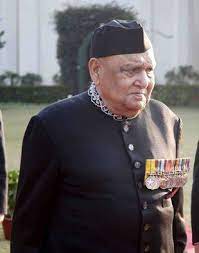
A meeting took place between the outgoing Army Chief Gen KV Krishna Rao and PM Gandhi somewhere in May 1983. Gen Rao was to demit office two months later on July 31, 1983.
Hours after the meeting, a midnight telephone call from New York awoke Lt-General SK Sinha, who was about to become the Army Chief. On the other side was Lt Gen Sinha’s daughter Minni who was in New York for higher studies. She excitedly said, “Congrats dad, you have become the chief.”
Sinha pacified her and apprised that the official decision was yet to be made. But Minni’s source was the most reliable one, her friend Lalita Krishna Rao, the daughter of the army chief, who had just spoken to her father and got the confirmation. However, since Lt Gen did not accede to Indira Gandhi’s demand of flushing out terrorists from the Golden Temple, he was superseded by a more pliable Gen AS Vaidya, who along with Lt Gen K Sundarji plotted and coordinated the entire operation.
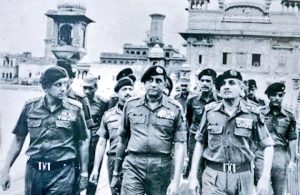
On June 1, two days before the Operation Bluestar was to commence, Major Gen AS Brar aka Bulbul Brar and his wife, both newly wedded were supposed to fly to Manila in Philippines for a month long holiday. The ticket had been booked. But a day before, on May 31, there was a hotline call to him from the Army Chief’s office. Brig Brar was asked to come to Chandimandir Cantonment immediately. Brig Brar (retd as Lt General) told his wife that he would be back by the evening and that they would fly to Manila the next day.
At Chandimandir, he was told to fly to Amritsar and that a division was already there. About his leave, it stood cancelled.
Before the operation began, Gen Brar put on his civilian clothes and took a round of the Golden Temple. There Gen Shahbeg Singh, who led the Khalistani militants noticed Brig Brar taking rounds of the Golden Temple.
On June 1, 1984, the militants took their position anticipating an attack. Outside Brig Brar was organising his troops.
Two months before operation Bluestar, Director General Security, an important official of the Research and Analysis Wing (RAW) walked into PM Gandhi’s residence. PM Gandhi and another top high ranking official RN Kao sat. Kao was the blue-eyed man of PM Gandhi, who was credited with grooming the Research and Analysis Wing (RAW) which was used to train Mukti Bahini guerrillas in 1971 during India-Pakistan war to free Bangladesh.
DGS briefed Mrs Gandhi and Kao on a mission that would be surgical in nature. Operation Sundown, so named, because it would begin in the middle of the night when the militants and Bhindranwale would be tired or half asleep. Commandos would enter the Guru Nanak Niwas guesthouse near the Golden Temple and abduct the man in question. Indira Gandhi did not concur. She was afraid the casualties would be too many. Though, two months later, more than 80 soldiers and 492 civilians died in Operation Bluestar.
The first explicit demand for Khalistan was made in 1940. But the story of Sikh Empire goes back to between 1799 to 1849. Before the advent of the British, Punjab was ruled by the confederacy of Sikh Misls founded by Banda Bahadur. The 12 Sikh Misls (a Misl is akin to a unit or a brigade) ruled over the entire Punjab between 1767 and 1799. Later it was united into the Sikh Kingdom by Maharaja Ranjit Singh for 40 years between 1799 to 1849. In the 1940s, when it became clear that India may be partitioned on religious lines into two countries, a few Sikh scholars thought of reimagining and giving shape to the old glorious Sikh Empire and thus the word Khalistan first was used somewhere in 1940s to denote an independent country.
Pre-partition Punjab comprised of lenhda Punjab (the Punjab of Pakistan), charda Punjab (present Punjab), and Haryana and Himachal. Its total area was 3,52,000 sq km which was more than the largest state of India today, Rajasthan, or roughly the size of present day Germany.
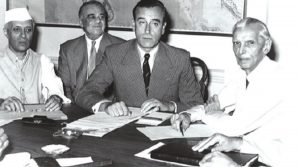
Sikhs, Muslims, and Hindus of Punjab suffered most of the violence and bloodshed during the partition. The day India and Pakistan were born, an arbitrary line drawn by Lord Cyril Radcliffe, the man who headed the Boundary Commission, about 33 days before the designated day, divided Punjab right through the middle.
However, before arriving at a decision, he took a flight over the entire Punjab region, looked down, by the time he alighted he had taken a casual decision in the eye of his mind. Speaking to author and journalist Kuldeep Nayyar he said, “I nearly gave you Lahore (meaning thereby he was about to give Lahore to India.” Later, he added, that since he had already given Calcutta to India, Lahore was thus awarded to Pakistan. The division of Punjab also meant that part of the heritage of Sikhs was taken away from them. They were driven out of Pakistan, where Nankana Sahib, the birthplace of Guru Nanak Dev and Kartarpur Sahib, the place where Guru Nanak Dev spent his last days. India’s Punjab then did not have Sikhs in majority since Punjab then had Himachal and Haryana as part of the state.
After partition, Punjab Subah movement had picked up pace in 1947 on the basis of Punjabi speaking area. The State Re-organisation Commission 1953 was set up but it did not give a favourable verdict saying that carving a state on linguistic grounds would give fuel to other communities asking for a separate state on the basis of language. The other reason it gave was that the Hindus of the Punjabi speaking areas of Punjab did not give their approval to it.
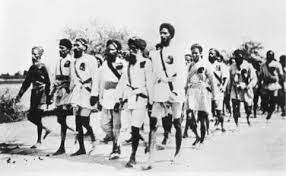
Those who were in favour of the Punjabi subah raised slogans such as ‘Punjabi Suba Amar Rahe’ and those against it raised slogans in favour of ‘Maha-Punjab.’ On April 6, 1955 the Deputy Commissioner of Amritsar banned both the slogans thinking that it will pacify both sides temporarily and result in peace at least for now.
Akali Dal called it an attack on the freedom of speech and expression. The movement, which was non-violent reached its crescendo in the first week of July 1955 when large number of Sikh volunteers reached Akal Takht. It was nothing more than a gathering but the administration and government grew suspicious about it.
Before the sunrise on July 4, 1955, the police raided the Golden Temple premises. The community kitchen was raided, following this the langar seva could not commence and the head priests of Golden Temple was also arrested. Inside, the police used teargas shells, outside a flag march was carried.
This action only gave more strength to the agitation. After 12,000 volunteers courted arrest as part of the agitation seeking lifting of ban on slogan for a separate Punjabi Suba, the chief minister Bhim Sen Sachar finally gave in to the demand on July 12 that year. The ban was lifted. The Punjab Re-organisation Act 1966 which dissolved the former state of East Punjab and carved Punjab, much smaller in size leaving Haryana and Himachal Pradesh out, was a direct result of Punjabi Subah movement – Punjab for only Punjabis. Around the same time, a 19-year-old teenager living an anonymous life Jarnail Singh Bhindranwale was enrolled in Damdami Taksal. He would shuttle between his village Rode and Damdami Taksal in Moga. He was the favourite student of the chief of Damdami Taksal, Kartar Singh.
Despite the implementation of the Punjab Re-organisation Act 1966, the 1971 General Election results and 1972 Vidhan Sabha poll results shocked the Shiromani Akali Dal. The party could win only one out of 13 seats in the Lok Sabha elections in Punjab. In the state assembly elections which followed in March 1972, Akalis were reduced to 24 seats in an assembly of 117 seats and Congress won a landslide majority. After this shocking defeat, the Akali Dal formed a sub-committee in December 1972 to introspect.
Subsequent to the ten meetings, a document drafted by Kapur Singh was adopted unanimously by the working committee of the Shiromani Akali Dal at a meeting held at Anandpur Sahib on October 16 and 17, 1973. This was called the Anandpur Sahib resolution. The most important thing it asked for was autonomy to Punjab apart from various other demands.
To get even with growing Akalis despite their loss in 1971 and 1972, PM Indira Gandhi’s younger son, who after the emergency had his foot pretty much in everything, also intervened in Punjab affairs.
In August 1977, Gurbachan Singh’s successor, Sant Kartar Singh the head of Damdami Taksal, who was involved in a car accident, died. But before his death, he appointed Bhindranwale as the head of Damdami Taksal over his son, Bhai Amrik Singh. Bhindranwale was still a Sikh preacher there was little currency to his name.
But all that started changing from the day of Baisakhi in the summer of 1978. A Sikh sect called Sant Nirankaris carried out a procession through the streets of Amritsar. The Nirankaris believe in a living guru, which amounts to sacrilege in Sikhism.
Bhindranwale gave a provocative speech against the Nirankaris. He led a march towards the procession. However, the Nirankaris were armed and killed 13 men marching with Bhindranwale.
This incident earned Bhindranwale the attention of the Congress. To get even with Akalis, Indira Gandhi’s younger son who pretty much had his foot in everything sought Sikh men, preachers if possible, who could look the present Akali dispensation in the eye. Zail Singh and Darbara Singh were the ones who identified Bhindranwale and another Sikh preacher. Both were ushered before Sanjay Gandhi who had Kamal Nath in his company. The first person they interviewed didn’t look impressive. The other one was Bhindranwale, who was tall, strong and had an intimidating voice and responded confidently.
However, the shifting of the case from Amritsar to Karnal and the subsequent acquittal of 62 Nirankaris and its head Gurbachan Singh accused of killing 13 Sikhs in the 1978 Baisakhi clash rankled many among the Sikh community. Shortly afterward, Nirankari chief Baba Gurbachan Singh was shot dead in Delhi. In the FIR 20 men were accused of the murder, including many Bhindrawale associates. Bhindranwale took abode in the Golden Temple to escape arrest till the Home Minister of India, Zail Singh announced in the Parliament that Bhindranwale had nothing to do with the killing of Baba Gurbachan Singh.
In 1981, Lala Jagat Narain wrote an editorial that in the upcoming Census, Hindus of Punjab should say that their mother tongue is Hindu. He was also a firm critic of Anandpur Sahib resolution. On 9 September 1981, Lala Jagat Narain, the owner-cum-editor of the Punjab Kesri newspaper was shot dead by two motorcycle-borne assailants at Chando Kalan.
Bhindranwale was at Mehta Chowk. Darbara Singh wanted his arrest to come what may. Police surrounded the premises where Bhindranwale was present. For negotiating Bhindranwale’s surrender, the senior officers went inside the gurdwara. Bhindranwale agreed to surrender on the condition that he will only surrender after delivering a sermon. He started giving a fiery speech claiming his innocence and his speech was received with rousing acclaim. Then Bhindranwale surrendered himself to the cops. The day was September 20, 1981.
On the day of his arrest, three motorcycle-borne assailants opened fire in Jalandhar killing four people and injuring twelve. The following day, at Tarn Taran a Hindu man was killed and thirteen people were injured.
On 25 September, a goods train was derailed at Amritsar. Four days later, an Indian Airlines airplane was hijacked. The plane was taken to Lahore. Several bomb blasts took place in Faridkot, Gurdaspur, and Amritsar.
Sanjay Gandhi, the man who had cultivated Bhindranwale died more than a year ago. Bhindranwale, the man, who about a year ago had campaigned for Congress candidate from Amritsar RL Bhatia had turned against the Indian state. Indira Gandhi was a worried Prime Minister.
Dharam Yudh Morch was a political movement that began in August 1982. It was helmed by Bhindranwale and Akali Dal. And its aim was the reiteration of the Anandpur Sahib resolution.
This was the time when Bhindranwale’s stature was bigger than the chief minister of Punjab Darbara Singh. A spate of assassinations started taking place. It began with Lala Jagat Narain’s killing on 9 September 1981 to the killing of Deputy Inspector General DIG of Punjab Police AS Atwal on April 25, 1983, outside the Golden Temple precincts took place. His body was removed only after Darbara Singh requested Bhindranwale, to let the police collect his body and Bhindranwale curtly said, “Lae javo (meaning take it away).” Such was the command of Bhindranwale that a CM had to request Bhinranwale to take away DIG Atwal’s body.
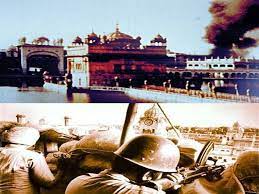
April 25, 1983, DIG Atwal was killed, a few days later a meeting happened between the outgoing Army Chief Gen KV Krishna Rao and PM Gandhi. The meeting was to decide who would be the next army chief. Lt Gen Sinha was superseded and Gen AS Vaidya became the army chief. On June 1, having abandoned his honeymoon plans, Brig Brar was at Amritsar.
Amritsar-based journalist, who used to report for the BBC remembers, “The entire week was very hot. Around the Golden Temple, there was a smell of gunpowder in the air. Our eyes were itching. The press had been thrown out. The shops had been forced to shut, telephone lines had been disconnected.”
On June 3, the Golden Temple complex had been surrounded by soldiers. Like Jarnail Singh Bhindranwale, whose surname (got in Punjab) was Brar, the man who was to head Operation Bluestar was also a Brar (Brig AS Brar). And both belonged to the same vicinity in Moga. While Bhindranwale was a rustic man raised in rural Punjab. Brar was an urbane, convent- educated man. Curfew was reimposed on the night on June 3, 1984. Firing briefly began on that night but stopped. It was the army’s way to open fire to scare the enemy. But Bhindranwale along with the ever-alert Gen Shahbeg Singh wasn’t ready to throw in the towel.
According to the book Amritsar, Indira’s Last Battle by Mark Tully and Satish Jacob, in the morning, even as young Sikhs holed up inside were ready to take on the army, Gurcharan Singh Tohra was ushered to where Bhindranwale was. He tried to convince him that the army was determined to kill him and that he should surrender. Bhindranwale looked at him angrily and called him Indira Gandhi’s agent.”
At 7:00 am on the morning of June 5, tanks hurtled past the Jallianwala Bagh, the colossal British mistake, and were headed to the Golden Temple. In another two days, the world would term this as a colossal mistake on the part of Indira Gandhi. For the next 15 hours, there weren’t many headways for the Indian forces. It was only at about 10:30 pm that Brig Brar launched a full frontal attack on the Akal Takht. Commandos were ordered to run down the steps beneath the clock tower onto the parikrama. But the moment they made their forward movement they faced heavy firing which resulted in casualties. According to Amritsar Indira’s Last Battle when commandos were not able to take position, Brig Brar was heard over the command network saying, “You bastards, why don’t you go in.”
When the commandos made headways, they were being fired at the knee level. This resulted in many injuries but just to the legs. In hindsight, the military experts revealed that Gen Shahbeg Singh may have assumed that the commandos would crawl. And the Sikh militants fired at knee level, which saved them from being hit on their heads and torso.
The Madrasis were supposed to enter from the southern entrance but they got lost in the byzantine lanes. When they finally arrived at about 3 am in the morning about five hours late. It was still dark and while entering they opened fire on 7 Garhwal Rifle soldiers. Commanding Officer of Garhwals AK Dewan then shouted: “Don’t Fire, I am the deputy GOC.” When the cock-up ended Dean launched a final assault but not without tanks.
Dewan, who was monikered Chicken for his long neck. But he had a heart of a lion. The brigadier should have left the real battleground to the battalion officers. But he was tempted to be part of the operation. That the troops were under heavy firing was an enticement for Dewan. When he was inside, he reported to Brig Brar, who had turned temperamental owing to the situation. He asked, “What the hell are you doing in there? I am commanding the operation. You don’t move without my orders.”
But tanks or no tanks was the question. The request went to Gen Sundarji. He spoke to Delhi; first to deputy defence minister KP Singh Deo. Two hours after Brig Dewan had sought forward movement of tanks, he had permission. The effect of the tanks hurtling into the Golden Temple was devastating. The front of the shrine was completely destroyed and brought down. As the tanks came in, Bhindranwale along with his 45 followers went into the main hall and prayed before the Akal Takht. After the prayers, he asked his followers that “those who want martyrdom, come with me, rest can leave and surrender.”
Eighty-three Indian Army soldiers were killed and 79 injured according to the figures released by the Indian Army. The number of Sikh militants and civilians killed was 554. Though, Rajiv Gandhi later admitted that nearly 700 soldiers were killed.
Many prominent Sikhs like journalist Khushwant Singh and Bhagat Puran Singh returned awards and decorations conferred upon them. Zail Singh, the president of the country who had not been informed about Operation Bluestar was deeply distressed. On June 7, there was a mutiny in the 9th Battalion of the Sikh Regiment and the Sikh Regimental Centre in Bihar.
On October 30, 1984, Indira Gandhi addressed a crowd of 10,000 people in Bhubaneswar. The most important words of her speech on that day were, “Meri khoon ki har boond Bharat ki ekta ko mazboot banayegi” (Every drop of my blood will work towards the unity and integrity of India).
A day later, on October 31, 1984, minutes after Satwant Singh and Beant Singh pumped bullets into Prime Minister Indira Gandhi’s body. When a wandering voice came probably from a commando, who killed Indira Gandhi? Sub-Inspector Beant Singh replied, “I.”
Four months after Indira’s assassination, in an interview with MJ Akbar, Rajiv Gandhi said, “At night, and often as we walked to the living quarters, a couple of times I wondered at his behaviour. He would stand with his gun pointed straight at me.”
Operation Bluestar took place in the first week of June. Bhindranwale was killed on June 6, and Indira Gandhi was assassinated four months later. But it didn’t stop at that. It took another nine years to eliminate terrorism in Punjab.
Advertisement